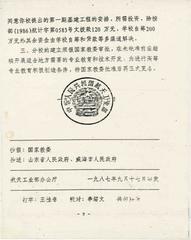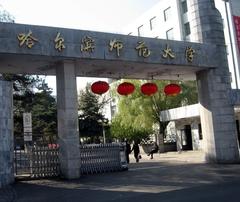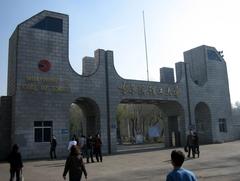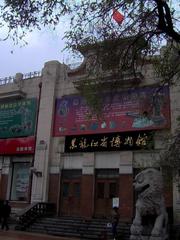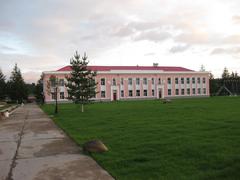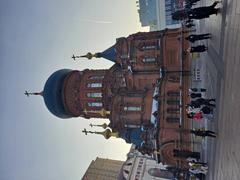Comprehensive Guide to Visiting Yushan Road, Harbin, People’s Republic of China
Date: 01/08/2024
Introduction
Yushan Road (玉山路) in Harbin, People’s Republic of China, is a captivating destination that embodies the rich historical and cultural tapestry of the city. Harbin, the capital of Heilongjiang Province, has evolved from a small fishing village into a cosmopolitan urban center, largely due to its strategic location in Northeast China and the construction of the Chinese Eastern Railway by the Russians in the late 19th and early 20th centuries (Travelling Welshman). This development brought a significant Russian population to Harbin, leaving a lasting imprint on its architectural and cultural landscape. Over the years, the city has also been influenced by Japanese occupation and various modernization efforts, all of which are reflected along Yushan Road. This guide will delve into the historical background, significant sites, and practical travel tips for visitors, offering a comprehensive overview of what makes Yushan Road a historical gem in Harbin.
Table of Contents
- Introduction
- Early Development and Cultural Influences
- Modern Development
- Significance of Yushan Road
- Key Historical Sites
- Preservation Efforts
- Visitor Tips
- Frequently Asked Questions (FAQ)
- Conclusion
Early Development and Cultural Influences
Harbin, the capital of Heilongjiang Province, has been a melting pot of various cultures due to its strategic location in Northeast China. Historically, the region known as Manchuria has seen significant influence from neighboring Russia and Japan, which is evident in the architectural and cultural landscape of Harbin today.
The development of Harbin as a major urban center began in the late 19th and early 20th centuries, primarily driven by the construction of the Chinese Eastern Railway by the Russians. This railway project not only facilitated economic growth but also brought a substantial Russian population to the city, leading to the establishment of a distinct Russian architectural style that can still be seen along Yushan Road and other parts of Harbin (Travelling Welshman).
Russian Influence
The Russian influence on Harbin is profound and multifaceted. During the early 20th century, Harbin became a haven for Russian émigrés fleeing the Bolshevik Revolution. This influx of Russian immigrants contributed to the city’s cultural and architectural heritage. Yushan Road, like many other parts of Harbin, features buildings with Russian architectural elements, including onion-domed churches and neoclassical facades. The most iconic example of this influence is the Saint Sophia Cathedral, a Russian Orthodox church that stands as a symbol of Harbin’s historical ties with Russia (CGTN).
Japanese Occupation
The darker chapters of Harbin’s history are also reflected in the city’s architecture and cultural memory. During the early 20th century, Harbin fell under Japanese occupation, which left a lasting impact on the city. The remnants of this period can be seen in various war museums and historical sites that document the atrocities committed during the occupation. These sites serve as a somber reminder of the city’s turbulent past and are an essential part of Harbin’s historical narrative (Travelling Welshman).
Modern Development
In recent decades, Harbin has undergone significant modernization while preserving its historical heritage. Yushan Road, in particular, has seen a blend of old and new, with modern buildings and amenities complementing the historical architecture. This juxtaposition of the past and present makes Yushan Road a fascinating area for visitors interested in exploring Harbin’s rich history and contemporary culture.
Significance of Yushan Road
Yushan Road holds a special place in Harbin’s urban landscape due to its historical and cultural significance. The road is not only a thoroughfare but also a living museum that showcases the city’s evolution over the past century. Walking along Yushan Road, visitors can experience the architectural diversity that characterizes Harbin, from Russian-style buildings to modern skyscrapers.
Key Historical Sites
Saint Sophia Cathedral
One of the most prominent historical sites near Yushan Road is the Saint Sophia Cathedral. Built in 1907, this Russian Orthodox church is a prime example of Byzantine architecture and serves as a symbol of Harbin’s Russian heritage. The cathedral has been converted into a museum, offering visitors a glimpse into the city’s multicultural past (CGTN).
- Visiting Hours: 9:00 AM - 5:00 PM
- Tickets: ¥20 (approx. $3)
Harbin Jewish New Synagogue
Another significant historical site is the Harbin Jewish New Synagogue, which reflects the city’s once-thriving Jewish community. Established in the early 20th century, the synagogue has been restored and now functions as a museum, documenting the history and contributions of Jewish immigrants to Harbin’s development.
- Visiting Hours: 9:00 AM - 4:30 PM
- Tickets: ¥15 (approx. $2.20)
Zhongyang Street (Central Avenue)
While not directly on Yushan Road, Zhongyang Street is a nearby pedestrian street that offers a similar historical experience. Known for its well-preserved European-style buildings, Zhongyang Street is a popular destination for tourists and locals alike. The street features a mix of architectural styles, including Baroque, Renaissance, and eclectic, further highlighting Harbin’s diverse cultural influences (Easy Tour China).
Preservation Efforts
Efforts to preserve Harbin’s historical sites, including those on Yushan Road, have been ongoing. The local government has implemented various measures to protect and restore these cultural landmarks, ensuring that they remain an integral part of the city’s identity. These preservation efforts are crucial for maintaining the historical integrity of Harbin and providing future generations with a tangible connection to the past.
Visitor Tips
For tourists visiting Yushan Road and its historical sites, here are some practical tips to enhance your experience:
- Dress Warmly: Harbin can be extremely cold in winter, with temperatures often dropping below -20°C (-4°F). Dress in layers and wear appropriate winter clothing, including thermal wear, gloves, and a hat (Easy Tour China).
- Plan Ahead: Check the opening hours and any entry fees for historical sites and museums. Some sites may require advance booking, especially during peak tourist seasons.
- Local Cuisine: Don’t miss the opportunity to try local delicacies such as Harbin sausage, Russian bread, and various street foods available along Yushan Road and nearby areas.
- Guided Tours: Consider joining a guided tour to gain deeper insights into the historical and cultural significance of the sites you visit. Local guides can provide valuable context and stories that enhance your understanding of Harbin’s history.
Frequently Asked Questions (FAQ)
- What are the visiting hours for Saint Sophia Cathedral?
- Visiting hours are from 9:00 AM to 5:00 PM.
- How much are tickets for Harbin Jewish New Synagogue?
- Tickets are priced at ¥15 (approx. $2.20).
By following these tips, visitors can make the most of their trip to Yushan Road and gain a deeper appreciation for Harbin’s rich historical heritage. Don’t forget to check out other related posts and follow us on social media for more updates.
Conclusion
Yushan Road in Harbin is more than just a street; it is a living testament to the city’s multifaceted history and cultural diversity. From the Russian-influenced Saint Sophia Cathedral to the Harbin Jewish New Synagogue, the area offers a unique glimpse into the past and present of this fascinating city. The preservation efforts by the local government ensure that these historical landmarks remain integral parts of Harbin’s identity, providing future generations with a tangible connection to the past. Visitors can enhance their experience by exploring nearby attractions such as Zhongyang Street and participating in guided tours that offer deeper insights into the historical and cultural significance of Yushan Road. Whether you’re a history enthusiast, architecture lover, or a curious traveler, Yushan Road promises a rich and rewarding experience. For more travel tips and updates, follow us on social media or download our mobile app Audiala.
